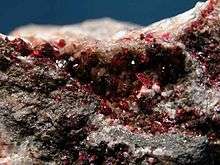Rozenite
| Rozenite | |
|---|---|
 | |
| General | |
| Category | Sulfate mineral |
| Formula (repeating unit) | Fe2+SO4•4(H2O) |
| Strunz classification | 7.CB.15 |
| Dana classification | 29.06.06.01 |
| Crystal system | Monoclinic |
| Crystal class |
Prismatic (2/m) H-M symbol: (2/m) |
| Space group |
Monoclinic Space group: P21/n |
| Identification | |
| Color | Colorless, white, pale green |
| Crystal habit | As concretions and nodules; most commonly as powdery efflorescences or coatings on melanterite |
| Mohs scale hardness | 2 - 3 |
| Luster | Vitreous to dull |
| Streak | White |
| Diaphaneity | Semitransparent |
| Specific gravity | 2.29 |
| Optical properties | Biaxial (-) |
| Refractive index | nα = 1.526 - 1.528 nβ = 1.536 - 1.537 nγ = 1.541 - 1.545 |
| Solubility | Water soluble |
| References | [1][2][3] |
Rozenite is an uncommon hydrous iron sulfate mineral, Fe2+SO4•4(H2O).
It occurs as a secondary mineral, formed under low humidity at less than 21 °C (70 °F) as an alteration of copper-free melanterite, which is a post mine alteration product of pyrite or marcasite. It also occurs in lacustrine sediments and coal seams. Associated minerals include melanterite, epsomite, jarosite, gypsum, sulfur, pyrite, marcasite and limonite.[1]
It was first described in 1960 for an occurrence on Ornak Mountain, Western Tatra Mountains, Małopolskie, Poland. It was named for Polish mineralogist Zygmunt Rozen (1874–1936).[1][2]
References
- 1 2 3 http://rruff.geo.arizona.edu/doclib/hom/rozenite.pdf Handbook of Mineralogy
- 1 2 http://www.mindat.org/min-3469.html Mindat.org
- ↑ http://webmineral.com/data/Rozenite.shtml Webmineral data
This article is issued from Wikipedia - version of the 11/4/2016. The text is available under the Creative Commons Attribution/Share Alike but additional terms may apply for the media files.